112/7 Shelves
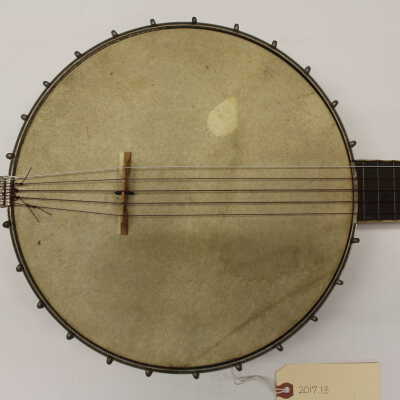
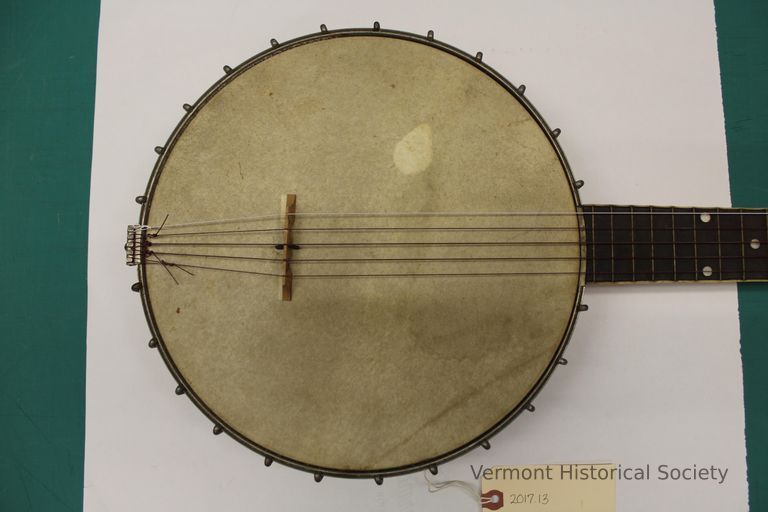
Banjo
Name/Title
Banjo
Lexicon
Description
Open-backed Bacon Professional Banjo, manufactured between 1910 and 1915. Five-stringed banjo with star inlay on headstock and neck. Neck is made of rock maple wood, with an ebonized maple fingerboard inlaid with pearl position marks. Fingerboard bound with white celluloid. Rim is also made of rock maple, with inlaid diamond marquetry along the bottom edge. S-shaped carvings on the rim cap. Nylon strings. Floating bridge manufactured by Grover. Manufacturers' markings on reverse of head and rim (see "Inscription" for specifics on markings).
Banjo was acquired by the donor at an online auction with the intention of donating it to the Vermont Historical Society.
The Bacon Professional Banjo Company was founded in 1906 by Frederick J. Bacon. Bacon was a professional travelling musician before he founded the company. His first factory was in Forest Dale, VT, where he was a resident. While it is thought that he contracted some early instruments with the Vega company in Boston, there are pictures of Bacon Banjo craftsmen in Forest Dale from 1910. Still, the instruments may not have been manufactured but simply assembled in Forest Dale.
Many of the Bacon Banjos had Vermont maple wood in their construction. Early models were five-string banjos, and pricing for these banjos ranged from $40 to $125. While the Bacon products were considered well-made banjos, they were nowhere near the caliber of instruments made by companies such as Vega. One of Bacon's contemporaries referred to his banjos as either "axe-handle" or "shoe-polish" banjos.
However, the demand for Bacon Banjos was enough that Bacon expanded his factory in 1913 and, in 1915, the Bacon Banjo Company was incorporated in Groton, Connecticut. There, Bacon developed his manufacturing and was joined by David L. Day from the Fairbanks banjo company. The instruments manufactured in Groton have a manufacturer's mark of "B&D" for Bacon and Day. The factory remained there until 1938, when a hurricane destroyed most of the manufacturing space. Since the popularity of banjos had declined by then, Bacon and Day decided to sell the remainder of their company to the Gretsch Company. Gretsch continued to make banjos under the Bacon name until the mid 1960s. Bacon spent the rest of his life teaching music and repairing instruments, as well as occasionally performing before his death in 1948.
Banjo was acquired by the donor at an online auction with the intention of donating it to the Vermont Historical Society.
The Bacon Professional Banjo Company was founded in 1906 by Frederick J. Bacon. Bacon was a professional travelling musician before he founded the company. His first factory was in Forest Dale, VT, where he was a resident. While it is thought that he contracted some early instruments with the Vega company in Boston, there are pictures of Bacon Banjo craftsmen in Forest Dale from 1910. Still, the instruments may not have been manufactured but simply assembled in Forest Dale.
Many of the Bacon Banjos had Vermont maple wood in their construction. Early models were five-string banjos, and pricing for these banjos ranged from $40 to $125. While the Bacon products were considered well-made banjos, they were nowhere near the caliber of instruments made by companies such as Vega. One of Bacon's contemporaries referred to his banjos as either "axe-handle" or "shoe-polish" banjos.
However, the demand for Bacon Banjos was enough that Bacon expanded his factory in 1913 and, in 1915, the Bacon Banjo Company was incorporated in Groton, Connecticut. There, Bacon developed his manufacturing and was joined by David L. Day from the Fairbanks banjo company. The instruments manufactured in Groton have a manufacturer's mark of "B&D" for Bacon and Day. The factory remained there until 1938, when a hurricane destroyed most of the manufacturing space. Since the popularity of banjos had declined by then, Bacon and Day decided to sell the remainder of their company to the Gretsch Company. Gretsch continued to make banjos under the Bacon name until the mid 1960s. Bacon spent the rest of his life teaching music and repairing instruments, as well as occasionally performing before his death in 1948.
Acquisition
Accession
2017.13
Made/Created
Date made
1910-1915
Manufacturer
Bacon Professional
Dimensions
Materials
Material
Wood, Metal, Celluloid, Nylon
Entry/Object ID
2017.13
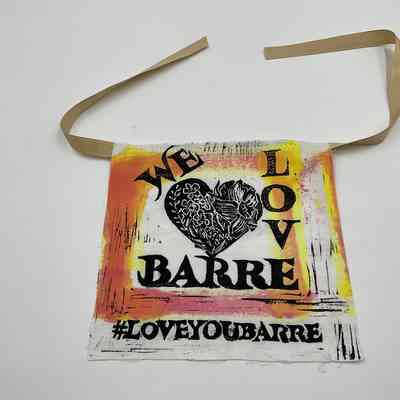

Banner
Name/Title
Banner
Lexicon
Description
Stamped square flag pennant designed by Dierdra Michelle. The pennant has a decorative heart in the center with a spray of flowers and is surrounded by the words "WE LOVE BARRE" and an orange, pink, and yellow painted rainbow border. Printed in black on the bottom is #LOVEYOUBARRE. The pennant has a taupe grosgrain ribbon sewn into the seam and a label on the back upper right corner for Dierdra Michelle Studio Arts with an Instagram QR code. The remaining three edges of the pennant are raw without hems.
This flag pennant was one of several designed and made by Michelle to support flood recovery efforts after the devastating July 2023 flooding.
This flag pennant was one of several designed and made by Michelle to support flood recovery efforts after the devastating July 2023 flooding.
Acquisition
Accession
2024.15
Relationships
Related Events
2023 Flood
Event
Related Person or Organization
Dierdra Michelle Studio Arts
Person or Organization
Related Places
,
Made/Created
Artist Information
Dierdra Michelle Studio Arts
Artist
Date made
2023
Dimensions
Materials
Material
Cotton
Entry/Object ID
2024.15.1
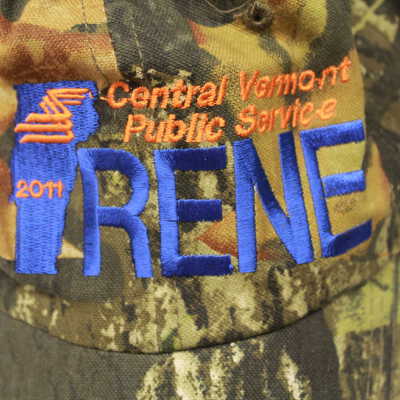

Cap
Name/Title
Cap
Lexicon
Description
Baseball-type cap of camouflage cotton fabric. Embroidered on front above visor: "Central Vermont/ Public Service" with logo and "2011" in orange, and in blue, "Irene" with outline of state of Vermont replacing the letter "I" Attached to top of cap is a cardboard label for "MOSSY OAK', (brand name). Inside visor is paper label with bar code and order or serial numbers. Printed along inside band is maker "PORT AUTHORITY" with fabric content, etc. At back is a band with velcro tabs for expansion.
Acquisition
Accession
2014.51
Relationships
Related Events
Hurricane Irene
Event
Made/Created
Date made
2011
Dimensions
Materials
Material
Cotton, Polyester, Paper
Entry/Object ID
2014.51.6
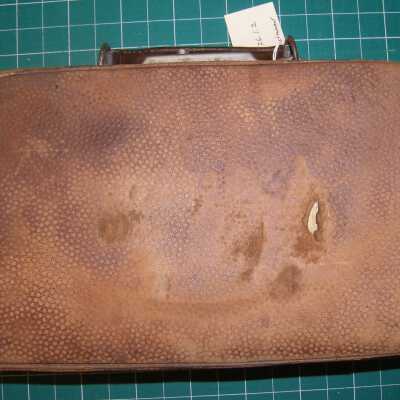
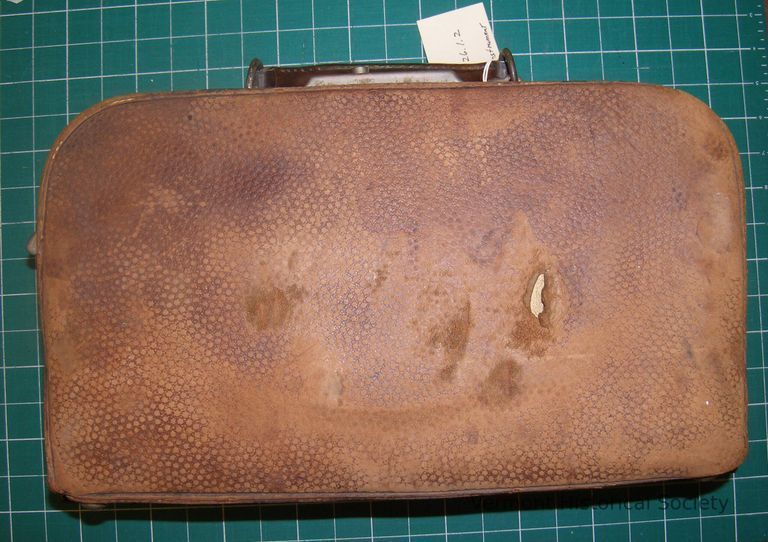
Case, Instrument
Name/Title
Case, Instrument
Lexicon
Description
Cornet case for 2010.26.1.1. Leather exterior with metal lock and side reinforcements for keeping the case closed. Metal frame extending around edges and leather-covered metal handle. Interior is purple velveteen in two sections. Interior of top section is deep and padded. The bottom section has a cover, the top of which has a form with leather strap and heavy snap to support the cornet and hold it in place. There are two indentations along top side for extra valves ? (empty) and small silver pivoting tabs to hold them in place. There are also two more pivoting tabs attached to the leather case to hold this cover in place. Along bottom edge are four holes for holding mouthpieces. Area below this cover is also deep and lined with purple velveteen. A piece of wood has been attached to the area beneath the lock, probably for reinforcement.
Acquisition
Accession
2010.26
Made/Created
Date made
1900-1940
Dimensions
Materials
Material
Leather, Suede, Metal, Wood
Entry/Object ID
2010.26.1.2
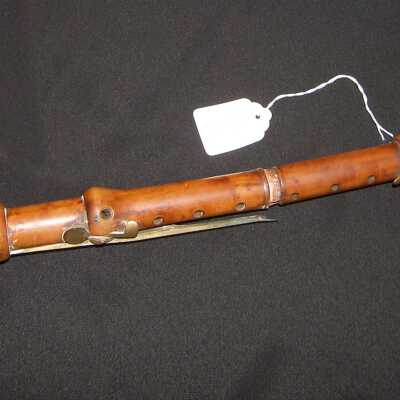
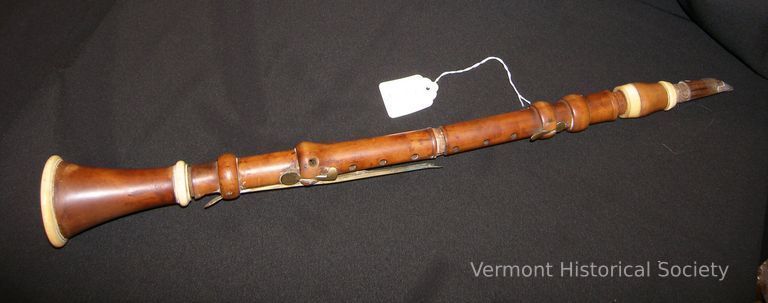
Clarinet
Name/Title
Clarinet
Lexicon
Description
19th century rosewood and boxwood clarinet. The mouthpiece (a) is made of rosewood with a metal tip, likely with a lead repair due to wear. The bottom edge is inset to fit into the next section (b) and is wrapped with thread. The next section is slightly pear-shaped, with ivory bands at the top and bottom edges. This section is imprinted "MARSH & CHASE" very faintly from an original wood burning stamp. The top fingering section (c) has three tone holes and spring-loaded brass levers to control two additional keys. Also branded into this section is "MARSH & CHASE / CALAIS, VT" with an image of an eagle in the center. The second fingering section (d) has four tone holes down the front and three additional brass levers covering key holes. There is a missing ivory band on the top edge of this piece. It is also imprinted with "MARSH & CHASE." The bell (e) has a polished surface, ivory bands at the top and bottom, and is imprinted with the same worn trademark as section c.
All sections have carved threading where they connect to adjoining pieces, but the threading has worn somewhat.
a= Rosewood mouthpiece, possible lead repair
b= Section next to mouth piece has ivory bands at each end. Barely legible printing on front: "MARSH & CHASE"
c= Next section has three tone holes and brass levers on front and back to control two other keys. Also printed on this piece but barely legible: "MARSH & CHASE/ CALAIS, VT." with an image of an eagle in center.
d= Next section has four tone holes down front, with two more brass levers and keys. An ivory band between (c) & (d) is missing. Also imprinted with "MARSH & CHASE"
e= The bottom end section is horn-shaped and is trimmed with ivory where it connects with (d) and around bottom edge. Imprinted with same trademark as on (c) but almost worn away.
All sections have carved threading where they connect to adjoining pieces, but the threading has worn somewhat.
a= Rosewood mouthpiece, possible lead repair
b= Section next to mouth piece has ivory bands at each end. Barely legible printing on front: "MARSH & CHASE"
c= Next section has three tone holes and brass levers on front and back to control two other keys. Also printed on this piece but barely legible: "MARSH & CHASE/ CALAIS, VT." with an image of an eagle in center.
d= Next section has four tone holes down front, with two more brass levers and keys. An ivory band between (c) & (d) is missing. Also imprinted with "MARSH & CHASE"
e= The bottom end section is horn-shaped and is trimmed with ivory where it connects with (d) and around bottom edge. Imprinted with same trademark as on (c) but almost worn away.
Acquisition
Accession
1991.35
Made/Created
Date made
1819-1836
Manufacturer
Marsh & Chase
Materials
Material
Rosewood, Ivory, Boxwood, Tin
Entry/Object ID
1991.35.1a-e
Context
Cousins Perry Marsh and Nelson Chase made fifes, clarinets, and pianos in Calais from 1819 until 1836.


Commemorative Button
Name/Title
Commemorative Button
Lexicon
Description
Round button printed with a black-and-white photograph showing a flooded area taken from the inside of a covered bridge. The inscription "IRENE 2011" rings the edge.
Acquisition
Accession
2012.58
Relationships
Related Events
Hurricane Irene
Event
Related Places
Place
Vermont
State/Province
United States of America
Country
North America
Made/Created
Date made
2011
Dimensions
Dimension Description
Overall
Materials
Material
Metal, Plastic
Entry/Object ID
2012.58.44
Context
Printed with an image of flooding damage during Hurricane Irene, 2011.

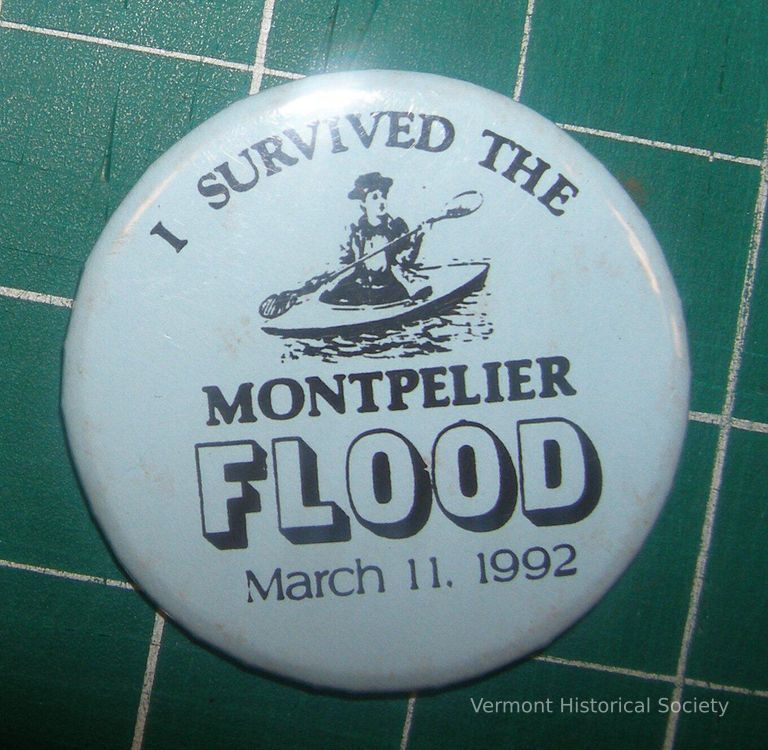
Commemorative Button
Name/Title
Commemorative Button
Lexicon
Description
Round light blue metal button printed in black with an image of a person in a small kaya and the words, "I SURVIVED THE MONTPELIER FLOOD March 11, 1992".
Acquisition
Accession
2013.9
Relationships
Related Events
1992 Flood
Event
Related Places
Place
Montpelier
City
Washington County
County
Vermont
State/Province
United States of America
Country
North America
Made/Created
Date made
1992
Dimensions
Dimension Description
Overall
Materials
Material
Metal
Entry/Object ID
2013.9.17
Context
The downtown area of Montpelier, Vermont, flooded in 1992 after an ice jam blocked the already high Winooski River during a spring thaw.
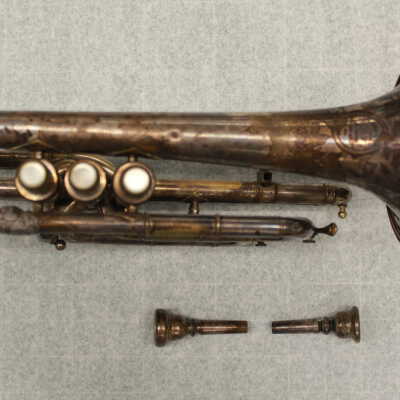
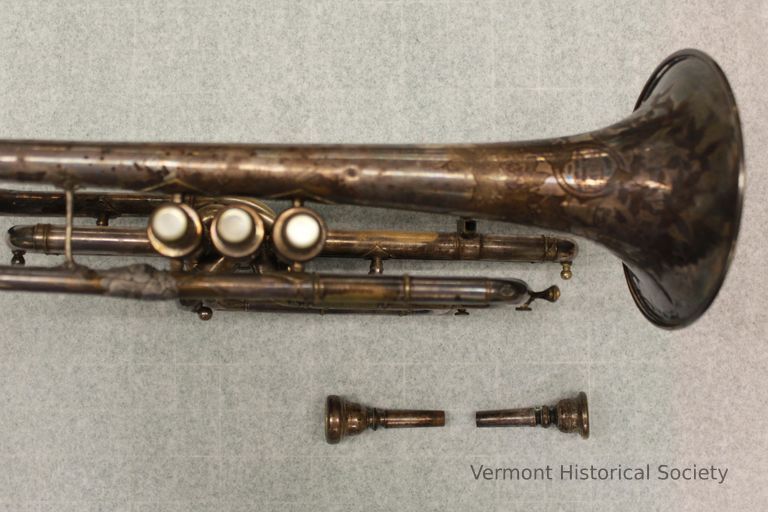
Cornet
Name/Title
Cornet
Lexicon
Description
a= Cornet used by George Cook of Corinth, VT. Horn is engraved with a leaf design and in center, in an oval frame, is the maker: "The/ Conqueror/ Made by C. A. CONN/ Elkhart. Ind." The heads of the valves are mother of pearl. There are two mouthpieces, (B) and (C).
b= Mouthpiece - is inscribed with maker "FORSELL MODEL/ The Vega Company/ 155 Columbus Ave, Boston"
c= Mouthpiece - is inscribed with maker "Levi Model CONN"
b= Mouthpiece - is inscribed with maker "FORSELL MODEL/ The Vega Company/ 155 Columbus Ave, Boston"
c= Mouthpiece - is inscribed with maker "Levi Model CONN"
Acquisition
Accession
2010.26
Made/Created
Date made
1900-1940
Materials
Material
Brass, Mother of Pearl
Entry/Object ID
2010.26.1.1a-c
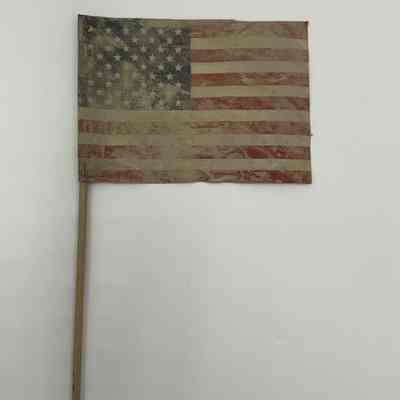
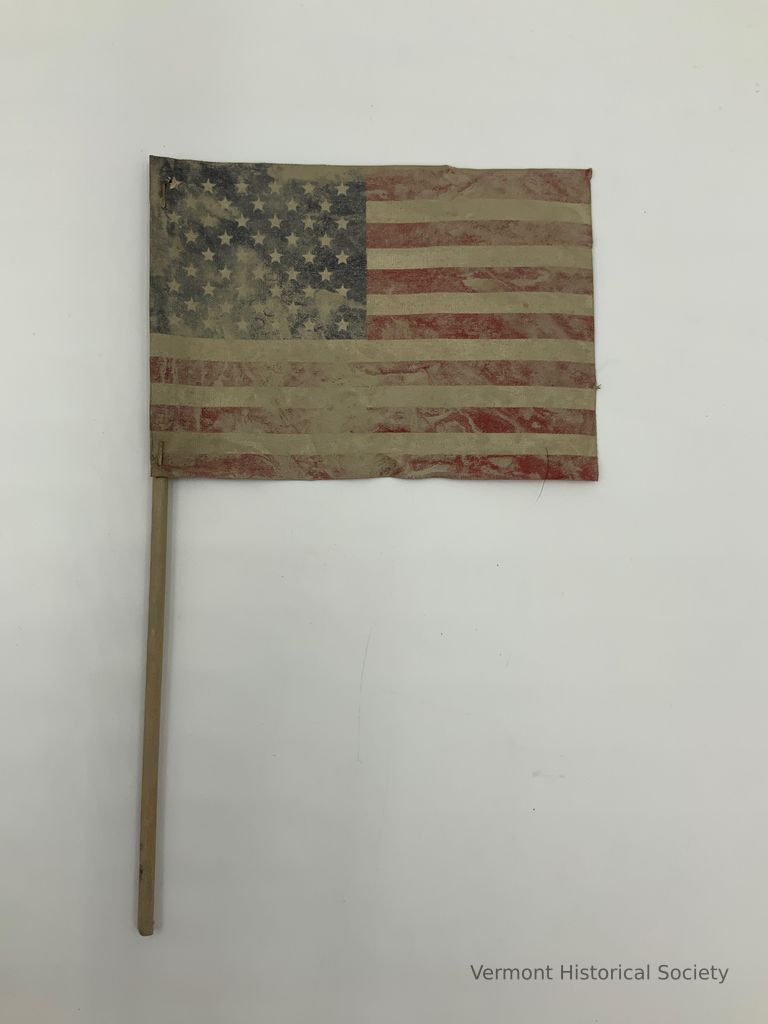
Flag
Name/Title
Flag
Lexicon
Description
Muddy paper American flag stapled to a wooden stick.
Acquisition
Accession
2023.25
Relationships
Related Events
2023 Flood
Event
Related Places
Place
Montpelier
City
Washington County
County
Vermont
State/Province
United States of America
Country
North America
Dimensions
Materials
Material
Paper, Wood
Entry/Object ID
2023.25.1
Context
Found in Montpelier after the July 2023 flood.
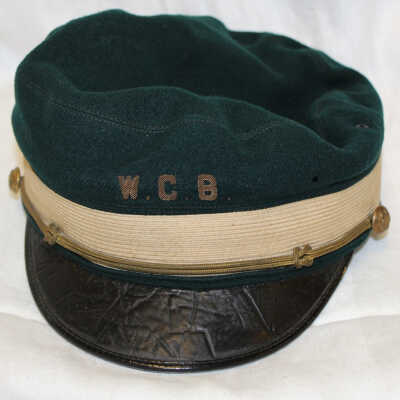

Hat
Name/Title
Hat
Lexicon
Description
Uniform hat with an unstiffened green wool crown and rounded black brim at the front. The base of the crown is wrapped with a white band. There is a brass button on either side of the brim that are connected with gold-colored cord. The initials "W.C.B." are embroidered with metal at the center front. The name "J.W. Buzzel" is written inside the hat.
Acquisition
Accession
1989.21
Relationships
Related Person or Organization
Waitsfield Cornet Band
Person or Organization
Related Places
Place
Waitsfield
Town
Washington County
County
Vermont
State/Province
United States of America
Country
North America
Made/Created
Date made
1893-1920
Dimensions
Dimension Description
Overall
Materials
Material
Wool, Brass, Leather, Cotton
Entry/Object ID
1989.21.7c
Context
Worn by J. W. Buzell as a member of the Waitsfield Cornet Band.
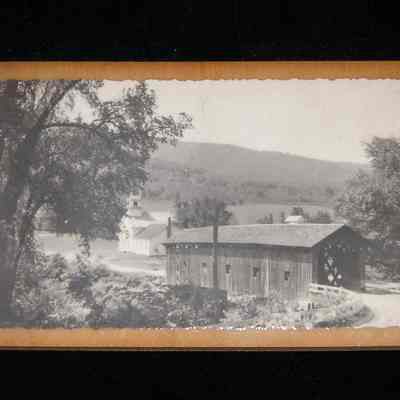
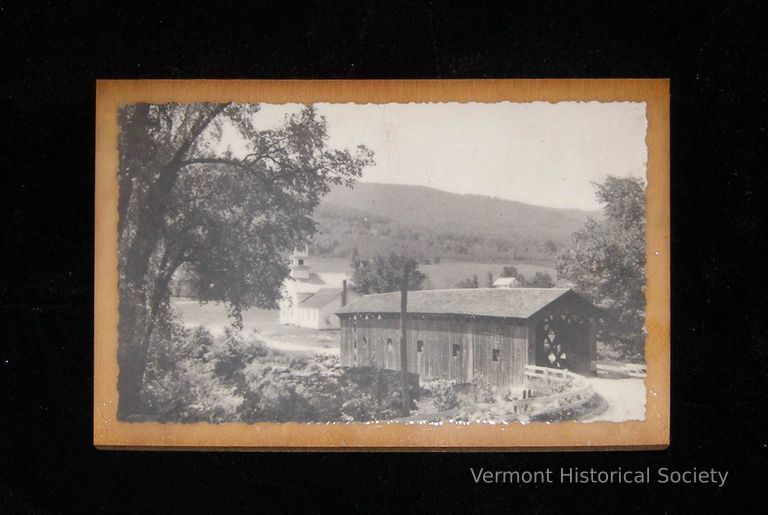
Plaque
Name/Title
Plaque
Lexicon
Description
Decoupaged photo on wood of a covered bridge with church in background. Photo has a scalloped edge. On back is a small ring attached near center top for hanging.
Acquisition
Accession
2004.2
Relationships
Related Places
Place
Arlington
Town
Bennington County
County
Vermont
State/Province
United States of America
Country
North America
Dimensions
Materials
Material
Wood, Paper, Metal
Entry/Object ID
2004.2.6
Context
Shows the West Arlington, Vermont, covered bridge.
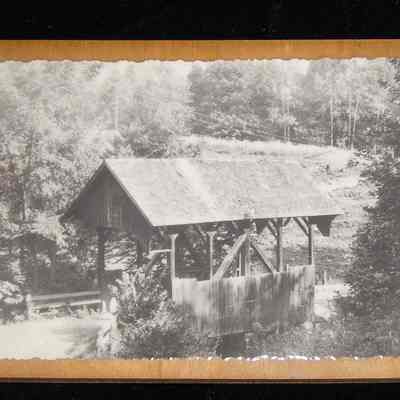
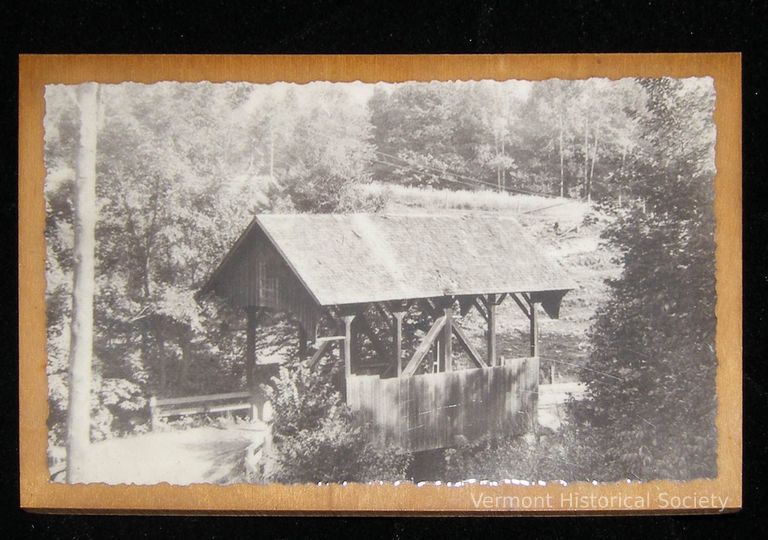
Plaque
Name/Title
Plaque
Lexicon
Description
Decoupaged close-up photo on wood of a covered bridge. Photo has a scalloped edge. On back is a small ring attached near center top for hanging.
Acquisition
Accession
2004.2
Dimensions
Materials
Material
Wood, Metal, Paper
Entry/Object ID
2004.2.7
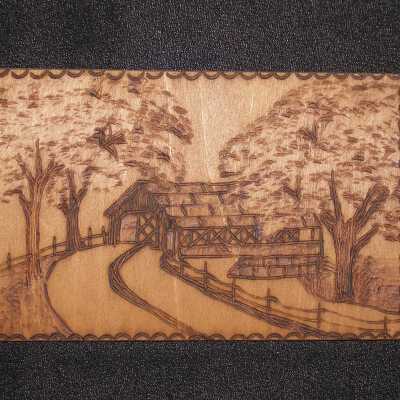

Postcard
Name/Title
Postcard
Lexicon
Description
Wood-burned postcard with a scene of a covered bridge and trees, and a scalloped edge. On obverse, also wood burned, "Post Card" in script at top, a line burned down center to separate address from greeting, and on left side, in script: "Greetings/ from/ Vermont" In one corner, written in pencil: "3 (cent) / stamp" Also on obverse, remnant of a grey plastic hanger.
Acquisition
Accession
2004.2
Dimensions
Materials
Material
Wood
Entry/Object ID
2004.2.5
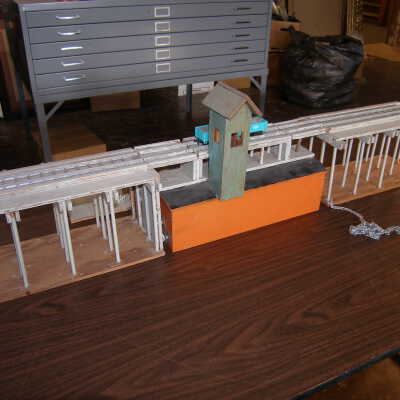
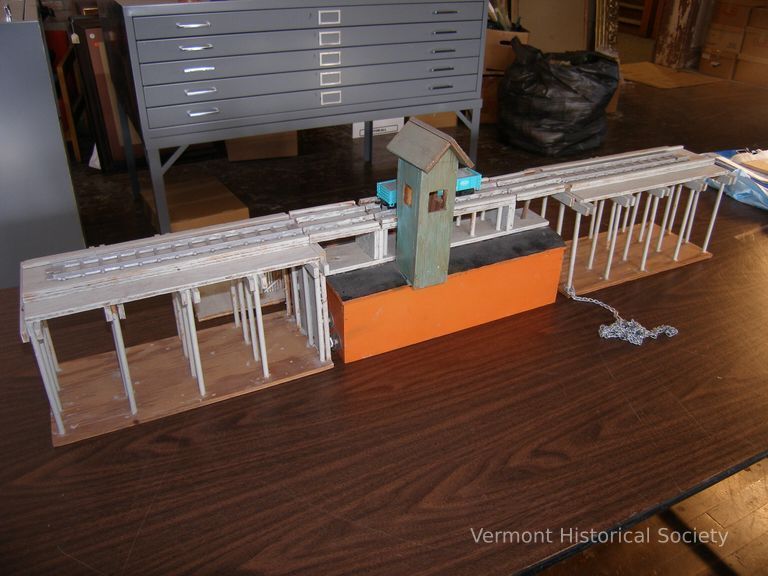
Scale Model
Name/Title
Scale Model
Lexicon
Description
Model of floating railroad bridge across Lake Champlain connecting Vermont and New York from Larrabee's Point to Ticonderoga. The bridge was composed of stationery piers from each shore joined by a floating barge hinged on one side. Powered by a steam engine. The barge would swing open for boats to pass through.
Acquisition
Accession
1970.11
Relationships
Related Places
Place
Lake Champlain
Lake
Burlington
City
Chittenden County
County
Vermont
State/Province
United States of America
Country
North America
Dimensions
Entry/Object ID
1970.11.1a-i
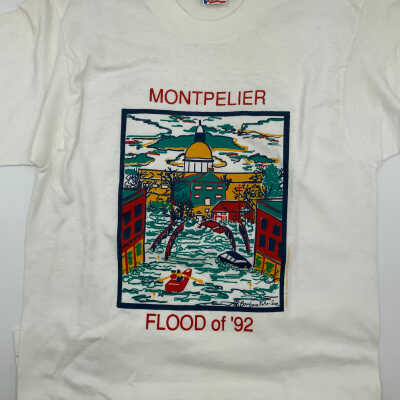
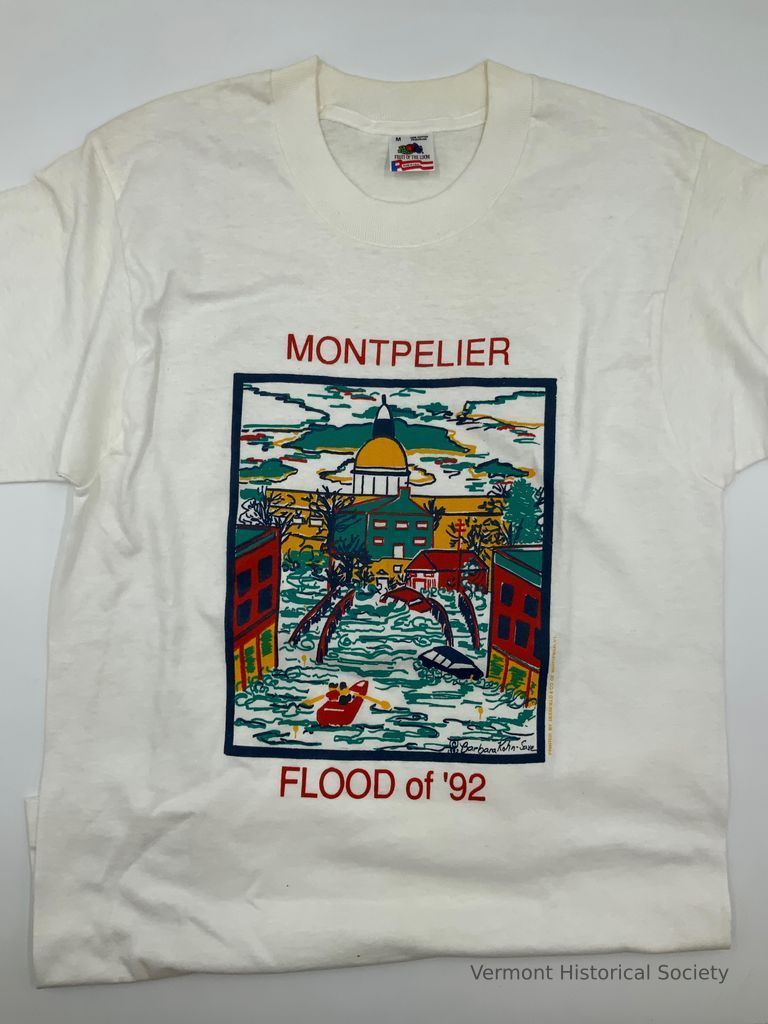
T-Shirt
Name/Title
T-Shirt
Lexicon
Clothing/Dress/Costume Details
Article of Clothing/Dress/Costume
Shirt
Textile Details
Jersey
Fabric
Cotton
Material
Overlock Stitch
Sewing Stitch Type
Clothing Sex
Unisex
Size
Medium
Description
White t-shirt printed with an illustration of a flooded city. The Vermont Statehouse is visible at the center horizon. There are people in a rowboat at the bottom center. The image is labeled, "MONTPELIER / FLOOD of '92." Size (M)edium.
Acquisition
Accession
2020.34
Relationships
Related Events
1992 Flood
Event
Related Places
Place
Montpelier
City
Washington County
County
Vermont
State/Province
United States of America
Country
North America
Made/Created
Artist Information
Kohn-Saxe, Barbara
Artist
Date made
1992
Manufacturer
Fruit of the Loom, Deerfield & Company
Dimensions
Entry/Object ID
2020.34.1
Context
Produced to commemorate the flood in Montpelier, Vermont, in 1992.
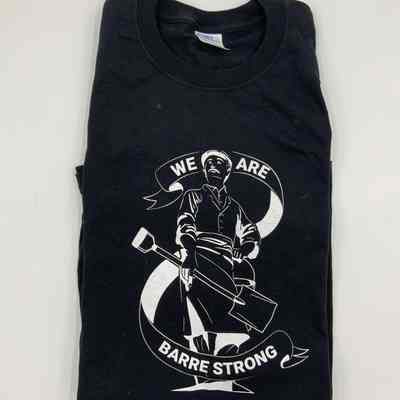
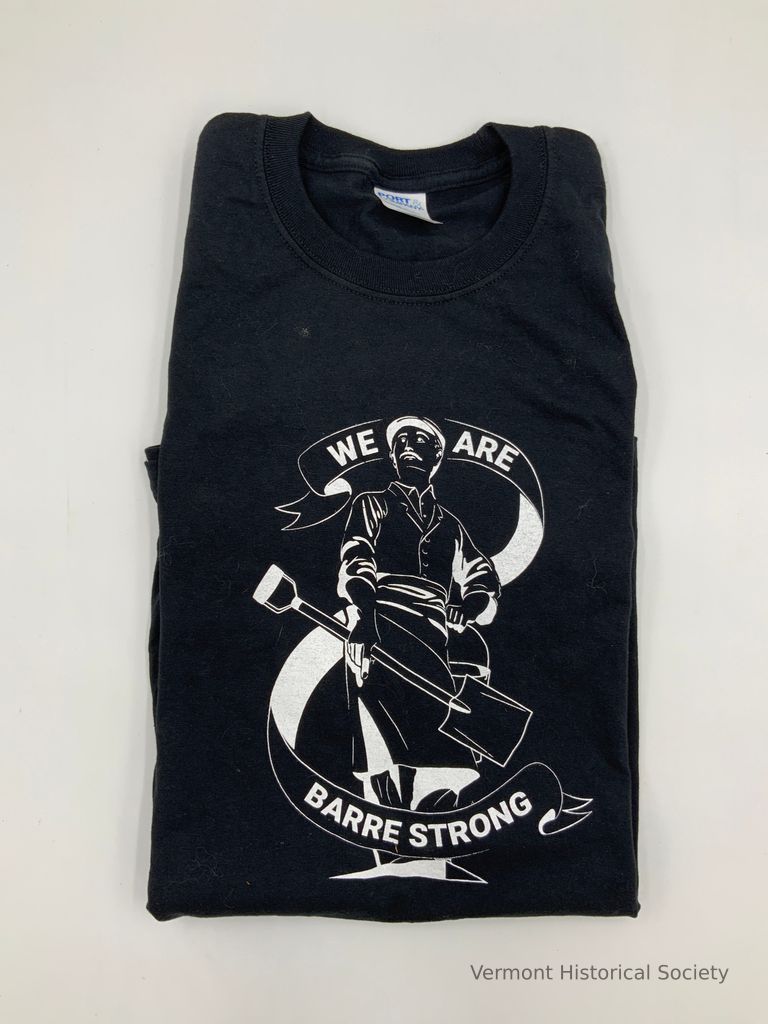
T-shirt
Name/Title
T-shirt
Lexicon
Clothing/Dress/Costume Details
Article of Clothing/Dress/Costume
Shirt
Textile Details
Black
White
Color
Cotton
Fabric
Clothing Sex
Unisex
Size
Large
Description
Black t-shirt with white printing to commemorate the 2023 flood in Barre, Vermont. The image on the front of the t-shirt shows a man in a collared work shirt, apron, and flat cap, and he is carrying a shovel. A ribbon swirling around the figure reads "WE ARE BARRE STRONG." Size (L)arge.
Acquisition
Accession
2024.7
Relationships
Related Events
2023 Flood
Event
Related Places
Place
Barre City
City
Washington County
County
Vermont
State/Province
United States of America
Country
North America
Made/Created
Date made
2023
Dimensions
Entry/Object ID
2024.7.1
Context
An account of the flood from the Year in Review in the Times Argus:
https://www.timesargus.com/news/local/year-in-review-the-flood-of-2023-and-its-lasting-effects/article_5df721ac-53bb-5875-8948-e09eba92ff79.html
“There is a lot of water,” Barre City Manager Nicolas Storellicastro said on July 10, after eight inches of rain had fallen on central Vermont, causing near-record flooding that left much of the Twin Cities and its neighboring towns under feet of water.
It did not match the infamous Flood of 1927, but it was close. A Barre man died as a result of the flooding, having fallen into waters in his basement. The damage to downtown Barre and Montpelier was staggering, as businesses and state government came to a halt. While the state’s offices could relocate, many businesses were stranded, with basement and first-floor inventory filled with water and toxic silt. Mountains of flood-damaged debris was stacked high on streets. Homes were destroyed — many of them in the north end of the Granite City.
For months, federal workers from the Federal Emergency Management Agency and the U.S. Small Business Association were taking inventory of the damage, and desperately trying to provide assistance to those who came forward.
The cleanup was a long, gross and tedious process. Ultimately, the flood claimed several central Vermont businesses and scores of homes in its wake."
https://www.timesargus.com/news/local/year-in-review-the-flood-of-2023-and-its-lasting-effects/article_5df721ac-53bb-5875-8948-e09eba92ff79.html
“There is a lot of water,” Barre City Manager Nicolas Storellicastro said on July 10, after eight inches of rain had fallen on central Vermont, causing near-record flooding that left much of the Twin Cities and its neighboring towns under feet of water.
It did not match the infamous Flood of 1927, but it was close. A Barre man died as a result of the flooding, having fallen into waters in his basement. The damage to downtown Barre and Montpelier was staggering, as businesses and state government came to a halt. While the state’s offices could relocate, many businesses were stranded, with basement and first-floor inventory filled with water and toxic silt. Mountains of flood-damaged debris was stacked high on streets. Homes were destroyed — many of them in the north end of the Granite City.
For months, federal workers from the Federal Emergency Management Agency and the U.S. Small Business Association were taking inventory of the damage, and desperately trying to provide assistance to those who came forward.
The cleanup was a long, gross and tedious process. Ultimately, the flood claimed several central Vermont businesses and scores of homes in its wake."
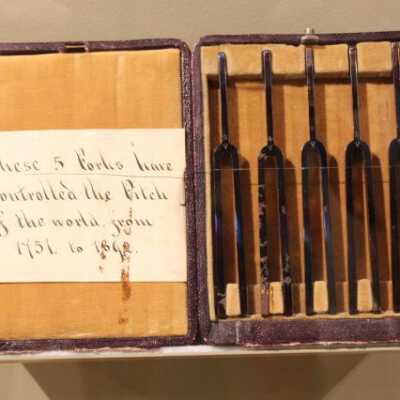
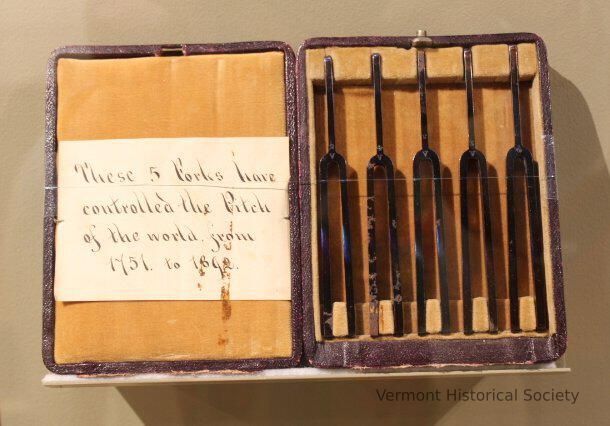
Tuning Forks
Name/Title
Tuning Forks
Lexicon
Description
In 1899 former Vermont Governor Levi K. Fuller exhibited his collection of over 300 tuning forks at the Boston branch of the Estey Organ Company. A newspaper clipping reporting on the exhibit was included with this case of tuning forks that Vermont Historical Society purchased in 1999. The exterior of this case is stamped in gold with Fuller's name and inside the cover was the note, "These five forks have/controlled the Pitch/of the world, from/1751 to 1892." Each fork is marked in gold with Fuller's name, a pitch and a composer's name. According to the article, a fork that Fuller owned marked "A422.5 Handel" was used by the composer when he conducted the Messiah in 1751. In 1892 Governor Fuller, the founder and owner of the Estey Organ Company, adopted the international pitch A435. These forks all are stamped "Valantine & Carr/Sheffield England" and were most likely a set Fuller made in the late 1800s. The forks are marked (left to right):
AI- A422.5 Handel; A2- A423.5 Mozart; A3-A433.2 Sir George Smart; A4-A454.7 Sir M. Costa; and A5-A452.5 Sir M. Costa
5 tuning forks in a case separated/broken at the hinge. Each fork has a mark at the top of the neck. a= A / 4" b= "A / 1" c= "A / 2" d= "A / 5" e= "A / 3" Each of the forks has a double diamond (diamond within a diamond) on the opposite side as the mark. Each fork has in gold the pitch on one tine and "L.K. FULLER" on the other. On the outside of the case: "A 422.5 - 423.5- / 433.2-452. 5-454.7" and at the bottom "LEVI.K.FULLER" Also on the inside of the case there is a hand written note that reads: "These 5 Forks have/ controlled the Pitch/ of the world, from/ 1751. to 1892." The inside is lined with gold velveteen. The outside is a thin "leatherette" (?) purple/black.
dark gray almost black
AI- A422.5 Handel; A2- A423.5 Mozart; A3-A433.2 Sir George Smart; A4-A454.7 Sir M. Costa; and A5-A452.5 Sir M. Costa
5 tuning forks in a case separated/broken at the hinge. Each fork has a mark at the top of the neck. a= A / 4" b= "A / 1" c= "A / 2" d= "A / 5" e= "A / 3" Each of the forks has a double diamond (diamond within a diamond) on the opposite side as the mark. Each fork has in gold the pitch on one tine and "L.K. FULLER" on the other. On the outside of the case: "A 422.5 - 423.5- / 433.2-452. 5-454.7" and at the bottom "LEVI.K.FULLER" Also on the inside of the case there is a hand written note that reads: "These 5 Forks have/ controlled the Pitch/ of the world, from/ 1751. to 1892." The inside is lined with gold velveteen. The outside is a thin "leatherette" (?) purple/black.
dark gray almost black
Acquisition
Accession
1999.46
Relationships
Related Person or Organization
Fuller, Levi Knight (1841-1896), J. Estey & Company
Related Places
Place
Brattleboro
Town
Windham County
County
Vermont
State/Province
United States of America
Country
North America
Made/Created
Date made
circa 1895
Manufacturer
Valantine & Carr
Materials
Material
Steel
Entry/Object ID
1999.46a-g
Context
Collected by Levi K. Fuller of Brattleboro, Vermont. In addition to serving as Governor of Vermont, Fuller worked at Estey Organ Company, during which time he developed and patented the international standard pitch notation.
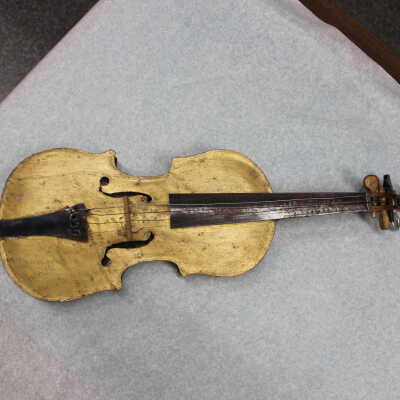
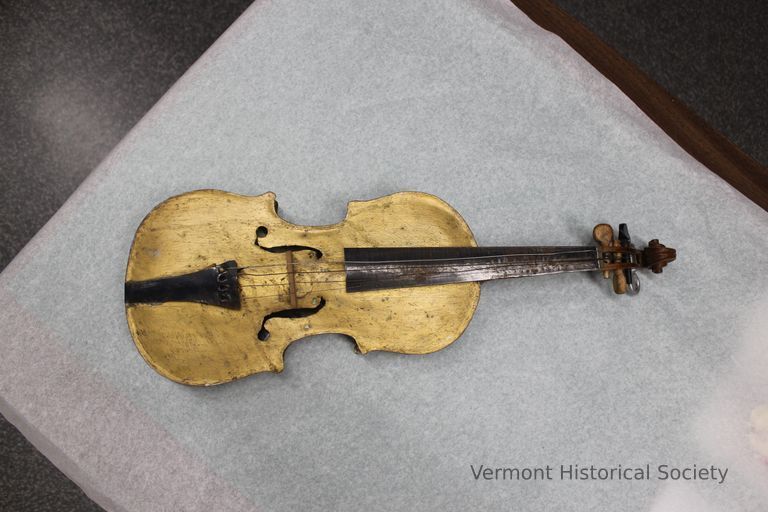
Violin
Name/Title
Violin
Lexicon
Description
Tin fiddle, bow and case. The fiddle and case were made by Forrest "Strad" Gray of East Calais, Vt. The fiddle has a tin body, a tin and wooden neck and a wooden bridge. The keys are both wooden and metal. The bow has been repaired and is commercial. The case is wooden and painted black. The body of the fiddle has been painted gold. This was used in "Always in Season," an exhibit of Vermont's folk art in 1982-3.
Forrest Gray was a tinsmith and self-taught musician. His began playing the fiddle as a young boy and was nicknamed "Stradivarius" which was shortened to "Strad" Gray made the body of this fiddle from the tin he was using to make water pails. If you look closely you will see other repairs he made using any materials that were convenient. A regular participant in concerts of the Northeast and Old Time Fiddler Associations, he won the Ninth Annual Old-Time Fiddlers Contest held at Craftsbury Common in 1971. Gray lived to be 103 and was a popular and entertaining member of the East Calais community.
See Worksheet for more information.
Forrest Gray was a tinsmith and self-taught musician. His began playing the fiddle as a young boy and was nicknamed "Stradivarius" which was shortened to "Strad" Gray made the body of this fiddle from the tin he was using to make water pails. If you look closely you will see other repairs he made using any materials that were convenient. A regular participant in concerts of the Northeast and Old Time Fiddler Associations, he won the Ninth Annual Old-Time Fiddlers Contest held at Craftsbury Common in 1971. Gray lived to be 103 and was a popular and entertaining member of the East Calais community.
See Worksheet for more information.
Acquisition
Accession
1986.26
Made/Created
Manufacturer
Gray, Forrest (1884-1987)
Dimensions
Materials
Material
Wood, Tin, Metal, Mother of Pearl
Entry/Object ID
1986.26.1a-c
Web Links and URLs